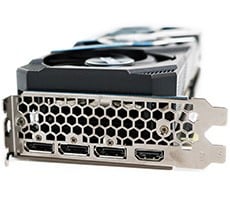AMD Ryzen 5 2400G And Ryzen 3 2200G Review: Raven Ridge Desktop Debuts
Ryzen 5 2400G In The Gigabyte AB350N-Gaming WiFi With G.SKILL Flare X RAM
When the Windows 10 installation was complete, we fully updated the OS, and installed all of the drivers necessary for our components. The patches for Spectre and Meltdown, however, were not installed. Auto-Updating and Windows Defender were then disabled, and we installed all of our benchmarking software, performed a disk clean-up, and cleared any temp and prefetch data. Finally, we enabled Windows Quiet Hours and let the systems reach an idle state before invoking a test.
|

|
We began our testing with the latest version of SiSoftware's SANDRA 2017, the System ANalyzer, Diagnostic and Reporting Assistant. We ran four of the built-in sub-system tests that partially comprise the suite with Intel's latest processors (CPU Arithmetic, Multimedia, Cache and Memory, and Memory Bandwidth). All of the scores reported below were taken with the CPUs running at their default settings, with 16GB of DDR4 RAM running at 2933MHz or 3200MHz, in-channel mode on Gigabyte AB350N-Gaming Wifi motherboard.
The Ryzen 5 2400G and Ryzen 3 2200G performed in-line with expectations according to SANDRA's processor arithmetic and multi-media tests. AMD's new APUs put up numbers roughly on-par with similarly clocked Ryzen processors and competed with Intel Core i3 and i5 processors of various generations (from Haswell, forward). Cache and memory latency was similarly competitive. And memory bandwidth fell in the 31.45GB/s (2933MHz) to 36.23GB/s (3200MHz) range, depending on the frequency. We included bandwidth numbers from both memory speeds to show AMD's officially supported maximum of 2933MHz and the XMP speeds of the G.SKILL memory kit used for testing.
|
PCMark 8 v2 is one of Futuremark’s series of popular PC benchmarking tools. It is designed to test the performance of all types of systems, from tablets to desktops. PCMark 8 offers five separate benchmark tests -- in addition to battery life testing -- to help consumers find devices that offers the perfect combination of efficiency and performance for their particular use case.
This version of the suite improves the Home, Creative, and Work benchmarks with new tests using popular open source applications for image processing, video editing, and spreadsheets. A wide variety of workloads have also been added to the Work benchmark to better reflect the way PCs are used in enterprise environments. These tests can be run with or without OpenCL acceleration. We chose to run with OpenCL acceleration enabled to leverage all of the platforms’ available CPU and GPU compute resources…

The Ryzen 5 2400G and Ryzen 3 2200G outpaced their predecessors according to PCMark 8 in the Work test, but lagged a bit behind in the Home test. Note that the standard Ryzen 5/3 processors require a discrete GPU, whereas the Ryzen 5 2400G and Ryzen 3 2200G were tested with their on-die Vega GPUs. Versus competing Intel Core i3 and Core i5 processors, Raven Ridge is competitive, but the latest-gen Core i5-8400 had a marked advantage.

We don't have a full set of PCMark 10 scores from current-generation desktop processors just yet, and the benchmark didn't want to run on our Core i5-8400 / Z-370 system for some reason, so we'll present these limited results for reference while we build up our database of scores. As you can see, the Ryzen 5 2400G trades victories with a Core i5-8250U. And the Ryzen 3 2200G's scores, save for the Essentials test, are somewhat better than a Core i5-7200U.














